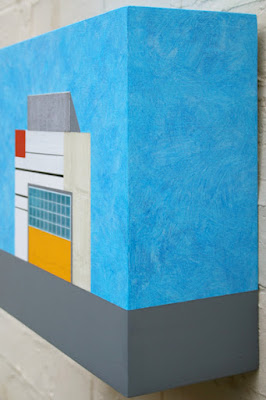Product details
Paperback: 192
pages
Publisher:
Columbia University Press (30 Sept. 2011)
Language: English
ISBN-10:
0231149913
ISBN-13:
978-0231149914
Product Dimensions: 1.3 x 14 x 21 cm
Review
What Goldsmith argues
has significant implications for the world of poetry, poetics, and
pedagogy. His book
contains brilliant moments of exegesis and archival documentation,
and its keen attention
to, knowledge about, and currency in artistic practice makes it as
much a user's manual
as a scholar's tome.--Adalaide Morris, The University of Iowa
Brilliant and elegant
insight into the exact relation of contemporary literary practices and
broader cultural
changes, explaining how the technologies of distributed digital media
exemplified by the
World Wide Web have made possible the flourishing of a particular type
of
literature.--Professor Craig Dworkin, author of "The Consequence of
Innovation: Twenty-
First-Century
Poetics"
In these witty,
intelligent essays, Goldsmith brings his encyclopedic knowledge of radical
artistic practice to
bear on how the rise of the internet has irrevocably changed, or should
irrevocably change,
our existing conceptions of poetry. Goldsmith's practice as artist and
critic is deeply
interesting. His book is sure to generate lively debate among poets, artists,
literary historians,
and media theorists.--Sianne Ngai, University of California, Los Angeles
Goldsmith achieves a
very difficult feat with this book: he writes lucidly about complex and
avant-garde ideas. As a result, he opens up a
vital debate for anyone who cares about
literature, between
notions of traditional creative writing and the set of practices he labels
"uncreative
writing."--Douglas Cowie"Times Higher Education" (01/01/0001)
Good.--James Franco,
actor
Multimedia artist and
executive manager of words, Goldsmith writes a provocative
manifesto for writing
in the digital era, with a treasure trove of ideas, techniques, and
examples that allow us
to make it new--again!--Marcus Boon, author of "In Praise of
Copying"
Brilliant and elegant
insight into the exact relation of contemporary literary practices and
broader cultural
changes, explaining how the technologies of distributed digital media
exemplified by the
World Wide Web have made possible the flourishing of a particular type
of literature.
--Professor Craig
Dworkin, author of The Consequence of Innovation: Twenty-First-Century
Poetics
A
stimulating and provoking read, which lays out Kenneth Goldsmith’s ‘Uncreative Writing’
agenda in accessible terms, whilst suggesting plenty of strategies for dragging
writing screaming into the digital era.
Goldsmith rightly asserts that literature has failed to take full
account of recent technological convolutions, or to properly build upon the
advances made by certain pre-digital, Modernist writers. As he admits, the logical conclusion of his
ideas about appropriation or bald transcription, may be a future in which
origination or human authorship dwindle away altogether – to be replaced by the
automated transfer of information as an end in itself. That implies our current age may be a mere
interim state - but one in which we might still have lots of fun playing with
his conceptual strategies, whilst awaiting our ultimate deletion. Alternatively, (should things prove to be not
quite so one-directional as that implies) It's tempting to speculate whether such
diversions might equally represent a more resilient ‘spirit’ - one capable of subverting algorithmic logic in somewhat less predictable ways.
- Hugh Marwood, Artist & Blogger.
What Goldsmith argues
has significant implications for the world of poetry, poetics, and
pedagogy. His book
contains brilliant moments of exegesis and archival documentation,
and its keen attention
to, knowledge about, and currency in artistic practice makes it as
much a user's manual
as a scholar's tome.
--Adalaide Morris, The
University of Iowa
In these witty,
intelligent essays, Goldsmith brings his encyclopedic knowledge of radical
artistic practice to
bear on how the rise of the internet has irrevocably changed, or should
irrevocably change,
our existing conceptions of poetry. Goldsmith's practice as artist and
critic is deeply
interesting. His book is sure to generate lively debate among poets, artists,
literary historians,
and media theorists.
--Sianne Ngai,
University of California, Los Angeles
Multimedia artist and
executive manager of words, Goldsmith writes a provocative
manifesto for writing
in the digital era, with a treasure trove of ideas, techniques, and
examples that allow us to make it new--again!
--Marcus Boon, author
of In Praise of Copying
Goldsmith achieves a
very difficult feat with this book: he writes lucidly about complex and
avant-garde ideas. As
a result, he opens up a vital debate for anyone who cares about
literature, between
notions of traditional creative writing and the set of practices he labels
"uncreative
writing."
--Douglas
Cowie"Times Higher Education" (01/01/0001)
Good.
--James Franco, actor
 |
| Kenneth Goldsmith |
About the Author
Kenneth Goldsmith is
the author of ten books of poetry and founding editor of the online
archive UbuWeb
(ubu.com). He is the coeditor of Against Expression: An Anthology of
Conceptual Writing and
the editor of I'll Be Your Mirror: The Selected Andy Warhol
Interviews, which was
the basis for an opera, "Trans-Warhol," that premiered in Geneva in
March of 2007. An
hour-long documentary of his work, Sucking on Words, premiered at the
British Library. He
teaches writing at The University of Pennsylvania and is a senior editor
of PennSound, an online poetry archive.
With thanks to: https://www.amazon.co.uk https://www.amazon.ca and (as ever), Andrew Smith - for the reading list.





















